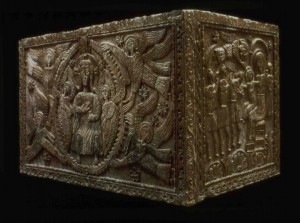Archaeologists excavating in the town of Cividale del Friuli in northeast Italy right across from the Slovenian border have unearthed a necropolis of more than 30 Lombard graves of men, women and children. It’s one of the largest Lombard burial grounds ever found.
The discovery is new so the remains haven’t been dated yet. Authorities have hired guards to protect the site, rich in artifacts, from looters. The goods interred along with the deceased are what mark the graves as Lombard.
Spears, swords, knives and bags containing coins and other iron objects were found in the men’s tombs while combs and clips were found in the women’s.
In most cases, ceramic vases had been placed at the foot of the graves. At the center of the necropolis was the tomb of a veiled woman with a bronze clasp pinning the cover to her head and a gold-embossed cross placed on her chest.
Some of the graves show signs of having been looted in the past.
 Cividale was the first major city conquered and occupied by the invading forces of Lombard King Alboin in 568. Italy had been severely depopulated by the Gothic Wars between the Byzantine Empire and the Ostrogothic Kingdom that ravaged the peninsula between 535 and 554 A.D. When Alboin crossed the Julian Alps from Pannonia into Italy, he encountered virtually no resistance. Byzantine troops were scarce at the border and the locals were in no condition to put up a fight. There is little evidence of battle violence in the archaeological record, and documentary sources confirm that Alboin basically just walked in and took it.
Cividale was the first major city conquered and occupied by the invading forces of Lombard King Alboin in 568. Italy had been severely depopulated by the Gothic Wars between the Byzantine Empire and the Ostrogothic Kingdom that ravaged the peninsula between 535 and 554 A.D. When Alboin crossed the Julian Alps from Pannonia into Italy, he encountered virtually no resistance. Byzantine troops were scarce at the border and the locals were in no condition to put up a fight. There is little evidence of battle violence in the archaeological record, and documentary sources confirm that Alboin basically just walked in and took it.
From Paul the Deacon’s 8th century Historia Langobardorum (History of the Lombards):
When Alboin without any hindrance had thence entered the territories of Venetia, which is the first province of Italy – that is, the limits of the city or rather of the fortress of Forum Julii (Cividale) – he began to consider to whom he should especially commit the first of the provinces that he had taken.
He chose his nephew Gisulf and made him duke of the new Duchy of Friuli with Cividale as its capital. This was as significant socially as it was politically, because before their migration to Italy the Lombards had avoided urban centers. From here on in, Lombard nobility would settle primarily in walled cities.
The Lombards would rule for the next hundred years until Charlemagne’s Franks defeated them in 773-774 A.D.
Needs more pictures. :skull:
I know, I know. I almost didn’t post about it because of the lack of pictures, but in the end I went for it just because there’s so little news to be had about late antiquity/early medieval archaeology and beggars can’t be choosers.
I have to wonder when graves stop being “looted” and start being dug up and “studied” back in the laboratory. Maybe its when there is no one left around to object–or when its the state versus some treasure hunter that is emptying the contents …seems like it’s the difference between profit and non-profit organizations.
I don’t think it’s a very fine line, at least not anymore. Thieves break into tombs with no consideration for their archaeological significance solely to profit monetarily from the sale of artifacts. Often they intentionally destroy the site to cover their tracks. Archaeologists excavate with toothbrushes and the artifacts they retrieve go to museums and schools and become invaluable parts of the public patrimony, even if they’re worth nothing at all in market terms.
That’s not to say archaeology has always had this outlook. Certainly the 19th century dawn of the profession featured many an adventurer taking a slash-and-burn approach. Schliemann destroyed the actual Homeric level of Troy in his quest to find it, and he defiantly stole the so-called “Priam’s Treasure” and smuggled it out of the country when Turkey demanded he cough up a share of the artifacts.